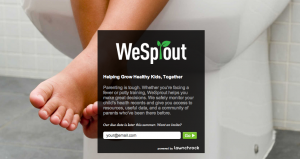PR Lessons from a Hipster and Epocrates Vet
We love PBR at Rock Health, but none of us suspected it would be part of a PR-worthy recruitment campaign. Doug Ludlow, Founder and CEO of Hipster, shared how his startup used it as part of a killer strategy to generate awareness, fundraise and hire the most qualified people around. Michelle Snyder, former SVP of marketing at Epocrates, spoke next and provided actionable advice from her experience generating high quality PR in healthcare.
Read on to find out how you can break through the clutter and get the features you want with just a little money and solid strategy. And maybe some of every hipster’s favorite beer.
Create a teaser page
Hipster engaged audiences with a pretty scene of their city and creative picture to leave them wanting more and were rewarded with a large number of signups. The number of signups exhibited to investors quantified interest. To get the desired viral effect, the right people need to get it first.
 Now a site called Launchrock provides a service to create a page just like this, which Rock Health startup WeSprout is utilizing.
Now a site called Launchrock provides a service to create a page just like this, which Rock Health startup WeSprout is utilizing.
Use PBR (or something like it)
While it won’t work for every company, doing something out of the box and clever will get the media and people interested. Below is the hiring campaign used to grab the attention of the talent Hipster wanted, as well as thousands of others in the media and tech worlds. It was smart and entertaining and clearly advertised their company culture.
Work with the right reporters
Reporters hate being scooped, so it is to your advantage to offer your story exclusively to certain reporters. Play them off each other, and take the extra time to tailor your story to these selected reporters. It will make it more likely that they want to cover you. Be sure to alternate who you offer the story to first, and don’t reveal too much.
From hipsters and the CEO’s perspective to one of the first employees at Epocrates. Michelle has extensive experience breaking into the medical world’s marketing and PR fortresses. The following is what she wished she’d known when she started:
Ask “So what?”
When you think you are finished with a press release, put it to the “So what?” test. If it doesn’t pass, go back to the drawing board. Getting the right angle on the story will be the difference between being heard and hearing crickets.
Get the most out your PR agencies
At a certain stage it might be appropriate to use a PR firm, but there are right and wrong ways to manage and hire them.
- 1) Have the firm pitch you your company. This ensures that they really know your product before they try to sell it to the press.
- 2) Pick your team. Forget about the fancy executives and find the lower level folks that you can trust to get the job done. Write who will be working on your account into your contract.
- 3) Give a grade at the end of each month to keep the group accountable for their work. This works with in-house PR departments, too. It offers a common language and scales communication across the organization.

Feed reporters facts and figures
Reporters love facts. They are always in search of ways to give their stories credibility, especially in health and medicine. So what could be better than having a 3rd party research study on your product? Epocrates partnered with Harvard for just such a study around doctors using their systems. This data became a valuable asset that they used for years. When you don’t have new products, your company can be a source of market information by presenting interesting facts through social media outlets and white papers.
Provide local users
Generate a list of users in different regions that are easily accessible to local reporters. That way if the Milwaukee Journal is writing a story, you can give them the contact information of a nearby cheesehead that uses your product.
Want more? Watch Doug and Michelle’s presentations on the Rock Health’s YouTube channel.

